Publications
Publications
Lessons Learned
Handbooks
Newsletters
News from the Front
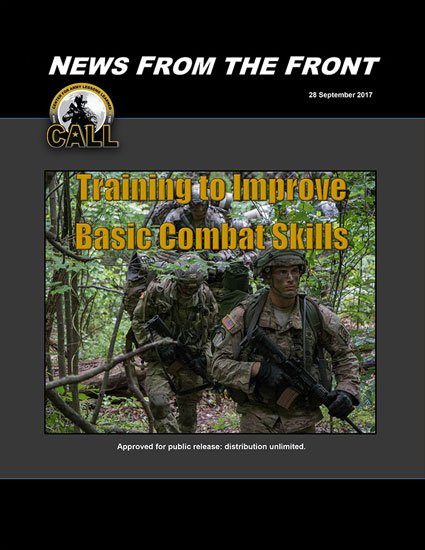 NFTF: Training to Improve Basic Combat Skills
NFTF: Training to Improve Basic Combat Skills
The purpose of this article is to illustrate how ROTC Cadet Command approached improving basic combat skills and fieldcraft through command emphasis, mission command, and the eight-step training model. While Cadet Command’s efforts are what inspired this document, the lessons and best practices are applicable for training programs for most junior Army leaders. This Center for Army Lessons Learned (CALL) document was produced with the cooperation and input of ROTC Cadet Command and ROTC Advanced Camp cadre and staff.
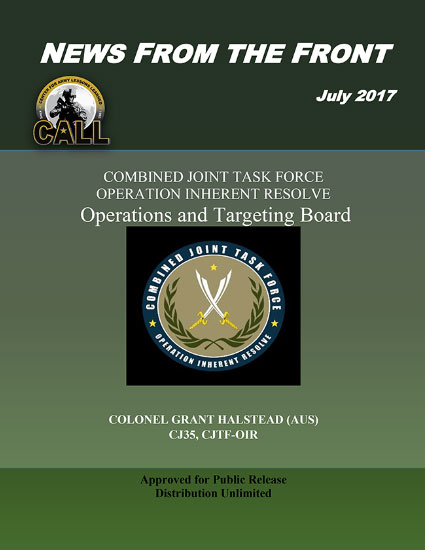 NFTF: COMBINED JOINT TASK FORCE OPERATION INHERENT RESOLVE Operations and Targeting Board
NFTF: COMBINED JOINT TASK FORCE OPERATION INHERENT RESOLVE Operations and Targeting Board
This NFTF gives an overview of the Combined Joint Task Force - Operation Inherent Resolve (CJTF-OIR) Operations and Targeting Board (OTB). The function of the OTB is to outline, de-conflict, and synchronize operations conducted in the Combined Joint Operations Area (CJOA) for the short-medium timeframe. The ultimate goal of the OTB is to maintain transparency while developing the CJTF-OIR Priority of Effort (PoE) and which informs the Weight of Effort (WoE) applied to each named operation. The WoE is then used to develop the Strike Allocation in order to communicate the Commander's intent for air asset apportionment during the execution week.
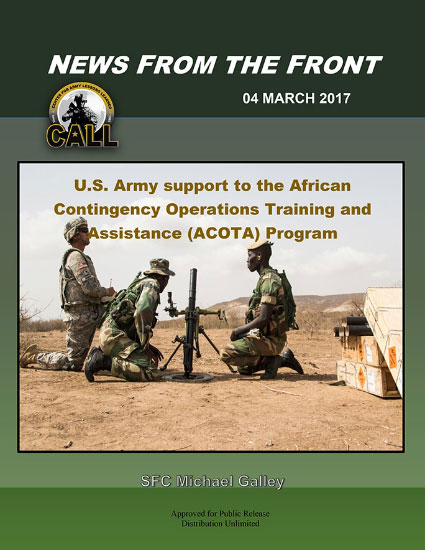 NFTF: U.S. Army Support to the ACOTA Program
NFTF: U.S. Army Support to the ACOTA Program
This News from the Front article briefly discusses the African Contingency Operations Training and Assistance (ACOTA) program and the 1-153’s mission in support of ACOTA. Specifically, this paper provides an example of U.S. Forces deployed to Africa engaging in a train and assist role to prepare a Ugandan mortar platoon for its upcoming peacekeeping mission to Somalia. This article can be used by small unit leaders deploying to Africa to prepare themselves and their units for an ACOTA mission.
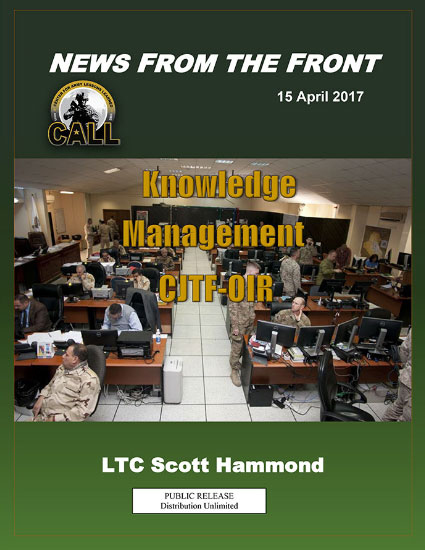 NFTF: Knowledge Management in CJTF-OIR
NFTF: Knowledge Management in CJTF-OIR
This News From The Front discusses how the III Corps addressed gaps in the knowledge management process within the CJTF. It illustrates some practical steps to address sharing of information in a combined joint headquarters that maybe adopted by knowledge managers and leaders in similar situations.
African Horizons is U.S. Army Africa's (USARAF) innovative approach to synchronizing Army activities over time to achieve strategic objectives. It links bilateral security cooperation (SC) activities with key influencers to achieve regional effects that build toward continental security in Africa. African Horizons was designed to increase the efficacy of USARAF as a theater army, improve readiness of both U.S. and African army forces through relevant and demanding training in austere environments, and expand the global land power network in Africa.
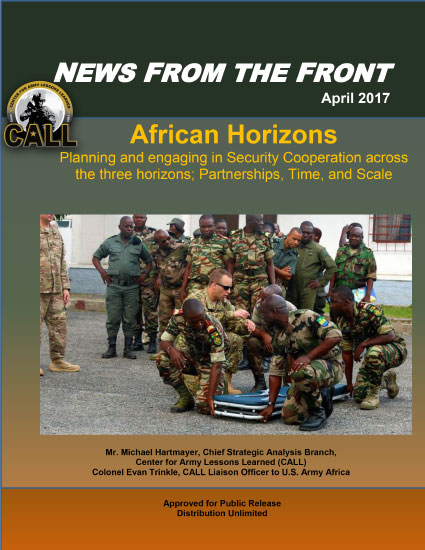 NEWS FROM THE FRONT - African Horizons
NEWS FROM THE FRONT - African Horizons
NEWS FROM THE FRONT - African Horizons: Planning and Engaging in Security Cooperation across the three horizons; Partnerships, Time and Scale.
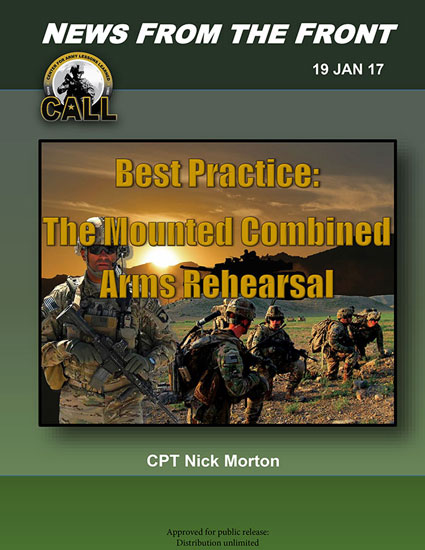 NFTF - Best Practice: The Mounted Combined Arms Rehearsal
NFTF - Best Practice: The Mounted Combined Arms Rehearsal
The mounted combined arms rehearsal (CAR) adds value to the traditional terrain model CAR and provides the additional benefit of exercising the Mission Command systems that will be used to conduct the operation.
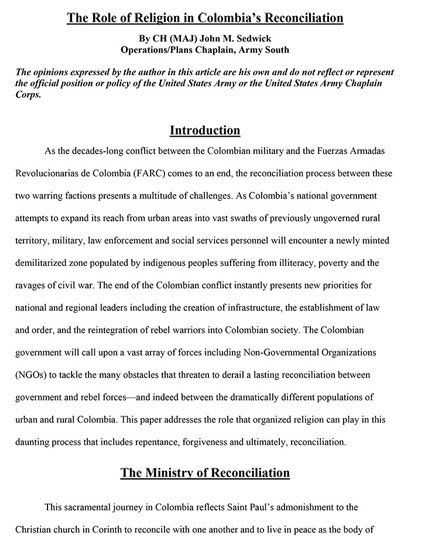 NFTF: The Role of Religion in Columbia's Reconciliation
NFTF: The Role of Religion in Columbia's Reconciliation
As the decades-long conflict between the Colombian military and the Fuerzas Armadas Revolucionarias de Colombia (FARC) comes to an end, the reconciliation process between these two warring factions presents a multitude of challenges. As Colombia’s national government attempts to expand its reach from urban areas into vast swaths of previously ungoverned rural territory, military, law enforcement and social services personnel will encounter a newly minted demilitarized zone populated by indigenous peoples suffering from illiteracy, poverty and the ravages of civil war. The end of the Colombian conflict instantly presents new priorities for national and regional leaders including the creation of infrastructure, the establishment of law and order, and the reintegration of rebel warriors into Colombian society.
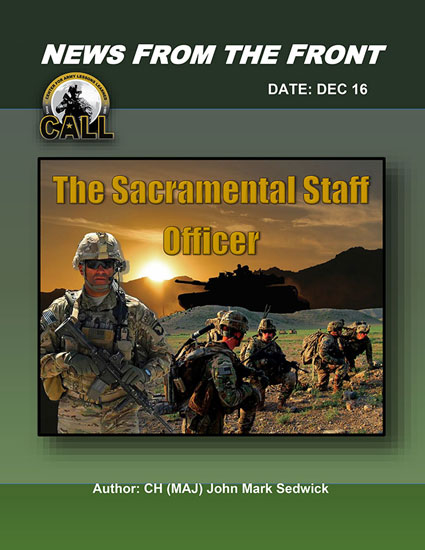 NFTF - The Sacramental Staff Officer
NFTF - The Sacramental Staff Officer
I have been blessed to read many pages from the metaphorical book that Saint Augustine describes in the above quote. Most recently I accompanied an Army South contingent of approximately 40 personnel to Santiago, Chile to participate as part of the Combined Forces Land Component Commander (CFLCC) element of the multinational exercise, PANAMAX, from 24 July to 7 August 2016. My mission included providing religious support to Army South personnel and, just as importantly, establishing a productive working relationship with a Chilean Army Chaplain to advise the Commander and respond to injects involving religious support at the CFLCC level.
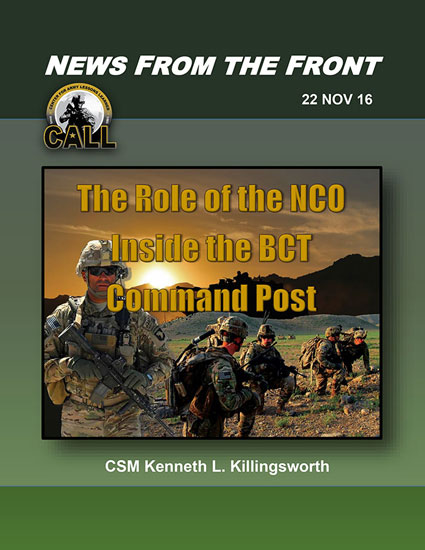 NFTF - The Role of the NCO Inside the BCT Command Post
NFTF - The Role of the NCO Inside the BCT Command Post
An NCO's role in a command post is truly no different than his or her role at the tactical level. NCO's organize Soldiers for the mission by creating a battle roster that reflects the Soldiers and equipment assigned. NCO's identify the training that needs to be conducted in each of the categories of a command post and create teams responsible for specific tasks that support the overall collective tasks of establishing the command post. NCO's create processes that support efficiency, both in the establishment and during operations of the command post, and then we rehearse those processes until they become as familiar as a battle drill. This is an NCO's role in a command post, the same role we have executed since the days of the blue book and the same duties and responsibilities we executed in those all too familiar company teams. It is our job to master those fundamentals of command post operations in order to bring the brigade combat team closer to mastering the fundamentals of combined arms maneuver.
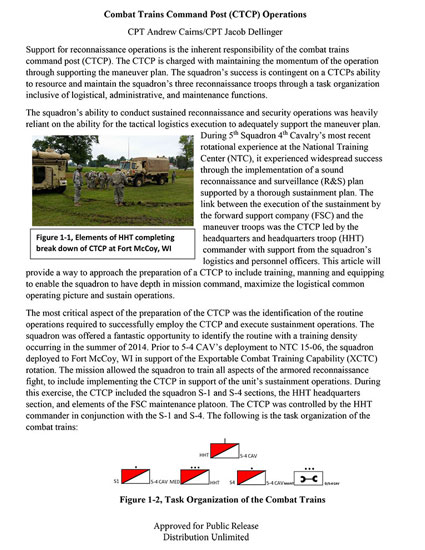 NFTF: Combat Trains Command Post (CTCP) Operations
NFTF: Combat Trains Command Post (CTCP) Operations
Support for reconnaissance operations is the inherent responsibility of the combat trains command post (CTCP). The CTCP is charged with maintaining the momentum of the operation through supporting the maneuver plan. The squadron’s success is contingent on a CTCPs ability to resource and maintain the squadron’s three reconnaissance troops through a task organization inclusive of logistical, administrative, and maintenance functions.
When it comes to providing comfortable living spaces for deployed Soldiers, rigid-wall shelters are a very particle solution when building the force base camp. Each rigid-wall shelter can house 10 Soldiers and be set up in less than 15 minutes by four people. Once they are up and running, the camps require little maintenance.
The Rapid Equipping Force provided rigid wall shelters to the Force Provider Camp – Erbil. This News From The Front covers the Lessons Learned while constructing the camp.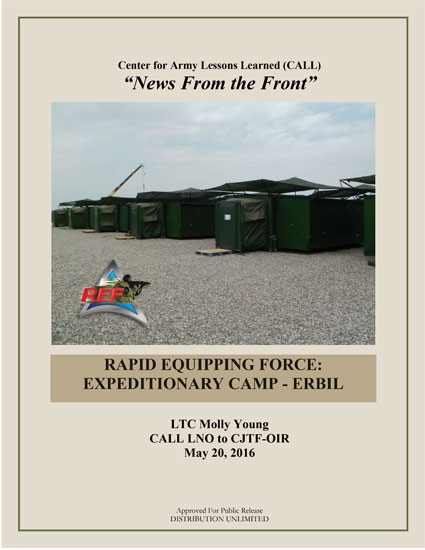 News From The Front: Rapid Equipping Force Expeditionary Camp - ERBIL
News From The Front: Rapid Equipping Force Expeditionary Camp - ERBIL
This News From the Front (NFTF) shares the story of U.S. Army Africa (USARAF) and highlights some of the creative ways it accomplishes its security cooperation goals on the continent. To that end, this NFTF addresses: 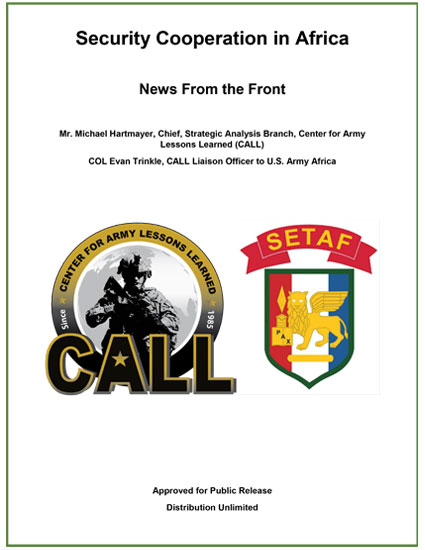 News From the Front: Security Cooperation in Africa
News From the Front: Security Cooperation in Africa
• Key USARAF insights on security cooperation in Africa.
• The African Land Forces Summit (ALFS).
• An interview with the USARAF Commanding General.
Pages
Other Products
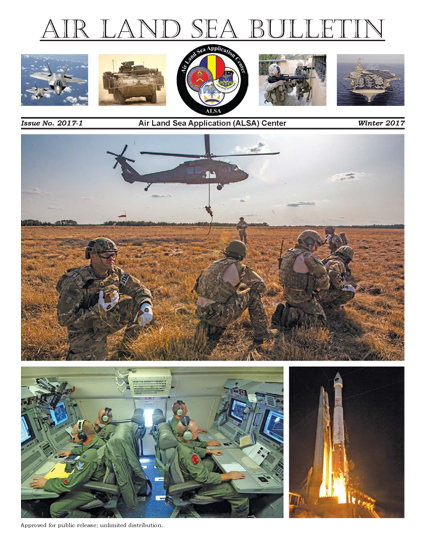 Air Land Sea Bulletin Issue 2017-1
Air Land Sea Bulletin Issue 2017-1
This Air Land Sea Bulletin (ALSB) is an open forum offering a wide mix of lessons learned, current status, and future considerations for warfighters. It contains a variety of articles that provide thought-provoking viewpoints and showcase the ingenuity and flexibility of United States (US) Service men and women.
This GTA provides US and Coalition service-members, units, and unified action partners (UAP) a quick pocket reference on how to efficiently treat casualties in a CBRNE- contaminated environment. Mainly for use by brigade combat teams (BCTs) and smaller units, it's organized to first provide self and buddy aid guidance, then progresses to a pictorial layout, equipment list and instruction to operate a more deliberate casualty decontamination site (with a doctrinal reference for more detail). The remaining cells provide symptoms' guidance for various types of CBRN agents and helps enable medical and non-medical personnel quickly differentiate between heat injuries and nerve agent poisoning. It closes with specific guidance on administering nerve agent antidote by injection, and uses pictures to help differentiate between the new and old model injectors. The GTA is ideal for home station training (HST) and dirt CTCs for echelons up to BCT-level, but can also be used for any training event or operational deployment with a potential CBRNE threat, to include homeland operations (HLO) and CWMD in the Republic of Korea (ROK), the ARCENT AOR or elsewhere. This GTA will be an attachment a future CALL Handbook on Combat Casualty Care (whose main body has no reference to contaminated casualty care). 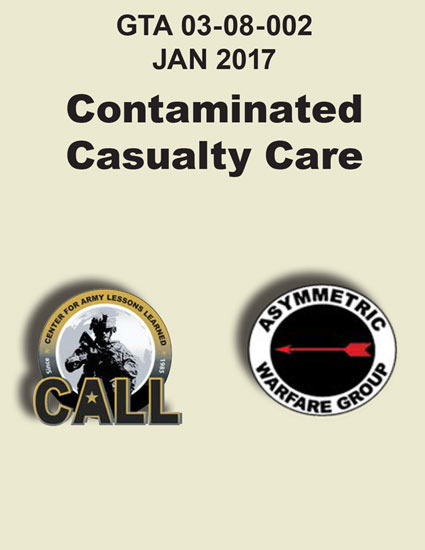 GTA 03-08-002 Contaminated Casualty Care
GTA 03-08-002 Contaminated Casualty Care
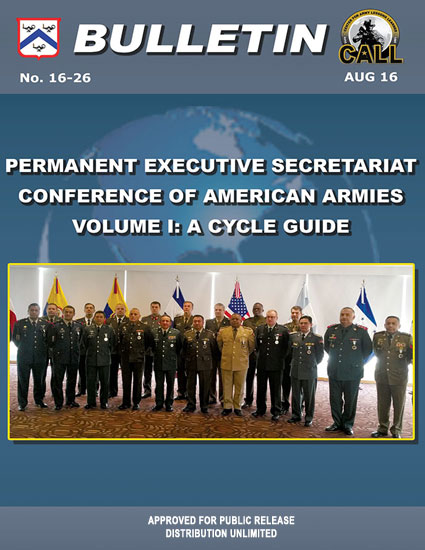 Bulletin 16-26: Permanent Executive Secretariat Conference of American Armies Volume I: A Cycle Guide
Bulletin 16-26: Permanent Executive Secretariat Conference of American Armies Volume I: A Cycle Guide
This bulletin contains valuable information to aid leaders, from all Conference of American Armies (CAA) member nations, in their knowledge on the goals, processes, and procedures as a contributing army, as well as, to better prepare them to assume the critical role of leading the CAA Permanent Executive Secretariat (PESCAA) in the future.
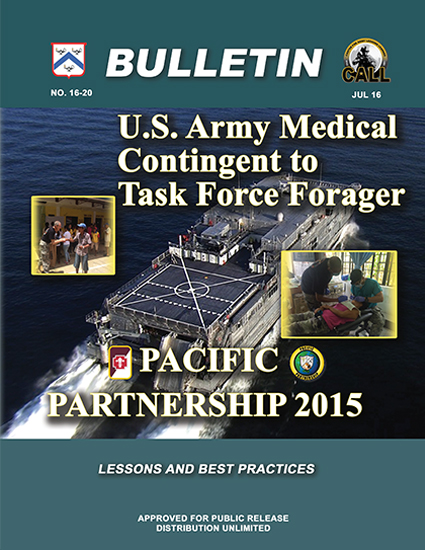 16-20 U.S. Army Medical Contingent to Task Force Forager
16-20 U.S. Army Medical Contingent to Task Force Forager
Global health engagements conducted in the Pacific theater by a U.S. Army medical task force are an example of the U.S. Army's continuous commitment and resolve to the security and stability of the Indonesia-Asia-Pacific region. The U.S. Army invested significantly in the rebalance to the Pacific, and Army medicine did its part with collaboration and participation in Pacific Partnership 2015 (PP15), a U.S. Navy-led multinational humanitarian assistance and disaster relief preparedness mission, conducted May through August 2015.
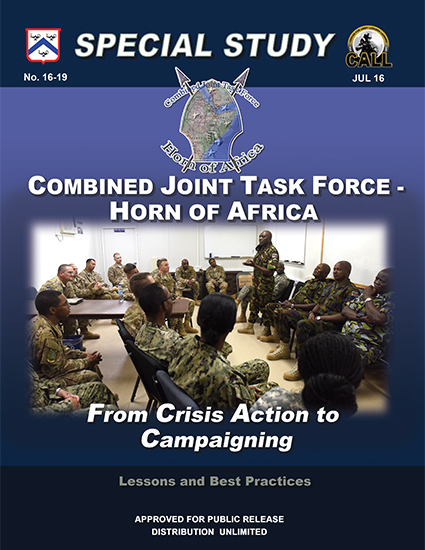 16-19 CJTF - Horn of Africa: From Crisis Action to Campaigning Special Study
16-19 CJTF - Horn of Africa: From Crisis Action to Campaigning Special Study
CJTF-HOA was established at Camp Lejeune, NC, in October 2002 in response to the September 11 attacks. The organization was formed around the 2nd Marine Division Headquarters, with the intent of identifying and destroying terror cells and violent extremist organizations in the region. This special study examines a significant shift in CJTFHOA’s focus: the transition from a short-term crisis, action-focused organization to a long-term campaigning headquarters. The shift is the result of a tremendous amount of blood, sweat, and tears by the men and women of CJTF-HOA in coordination with the USAFRICOM staff, the Service components, and our regional embassies.
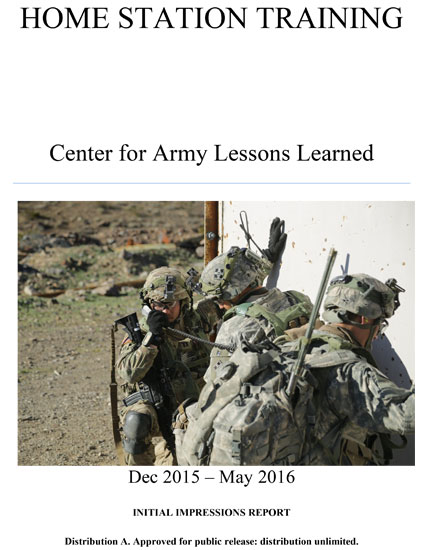 Home Station Training Dec 2015 – May 2016 Initial Impressions Report
Home Station Training Dec 2015 – May 2016 Initial Impressions Report
This report provides a summary of the observations from three Center for Army Lessons Learned (CALL) collection events concerning Home Station Training (HST) from December 2015 - February 2016. The collection team interviewed a total of over 250 Soldiers and Leaders from one Corps Headquarters, two Division Headquarters, three Brigade Combat Teams, and seventeen Battalions/Squadrons. This collection report includes analysis from the I CORPS Stryker Assessment dated January 2016. This report has been sanitized to remove unit identification.
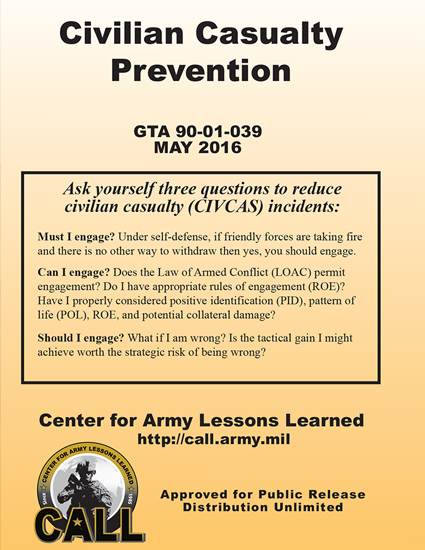 Civilian Casualty (CIVCAS) Prevention GTA 90-01-039
Civilian Casualty (CIVCAS) Prevention GTA 90-01-039
GTA 90-01-039, CIVCAS Prevention smartcard provides lessons, best practices, and consequence management steps to mitigate civilian loss of life and property (collateral damage) during the conduct of military operations. The May 2016 supersedes the previous version, entitled "Afghanistan Civilian Casualty Prevention," May 2012.
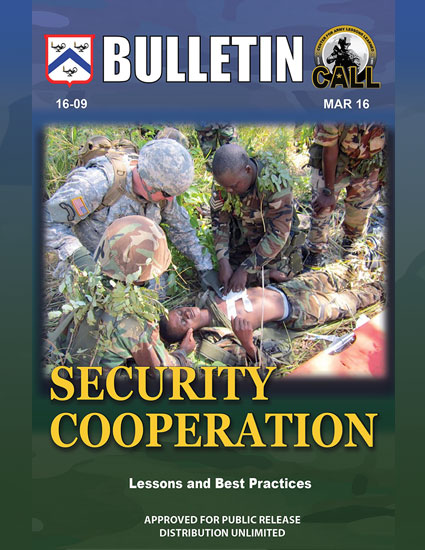 16-09: Security Cooperation Lessons and Best Practices Bulletin
16-09: Security Cooperation Lessons and Best Practices Bulletin
The routine military and interagency security cooperation (SC) activities the U.S. Army performs to deter potential adversaries and solidify our relationships with allies and partners are often described as shaping activities. Shaping the security environment is a cost-effective way to ensure peace and stability and prevent conflict. Our relationships with international partners are essential to protecting the national security interests of the United States and our allies. By helping to build the capacity and interoperability of our partners, the Army contributes to a more secure world.
In June 2014, CENTCOM instructed the US Army Central Headquarters to form the core of a Joint Forces Land Component Command (JFLCC), and with the addition of coalition forces, to a Coalition Forces Land Component Command (CFLCC) to conduct limited operation against Daesh (aka ISIL). As the operations against Daesh required full joint integration, CENTCOM ordered the transition of the CFLCC a CJTF, eventually becoming the Combined Joint Task Force-Operation Inherent Resolve (CJTF-OIR).
Soon after they handed over the CJTF responsibilities, ARCENT contacted the Mission Command Center of Excellence (MC CoE) with a request for a Center for Army Lessons Learned (CALL) collection team to document ARCENT Headquarters’ experience as they worked through the ASCC-CFLCC-CJTF transition, concluding with their operating as a CJTF. This Initial Impressions Report (IIR) is the collection of lessons, best practices, and insights based on the ARCENT Commander and his staff in transitioning from an ASCC to a CJTF.
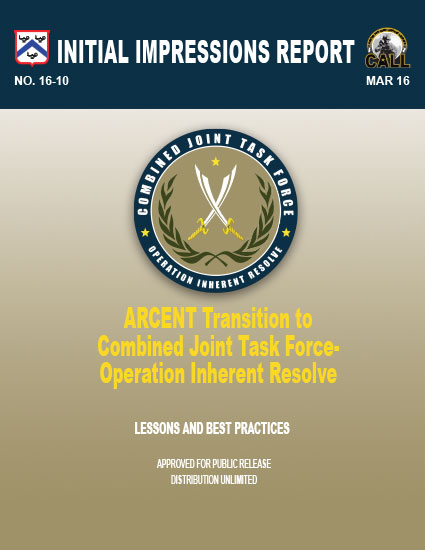 16-10: ARCENT Transition to Combined Joint Task Force - Operation Inherent Resolve
16-10: ARCENT Transition to Combined Joint Task Force - Operation Inherent Resolve
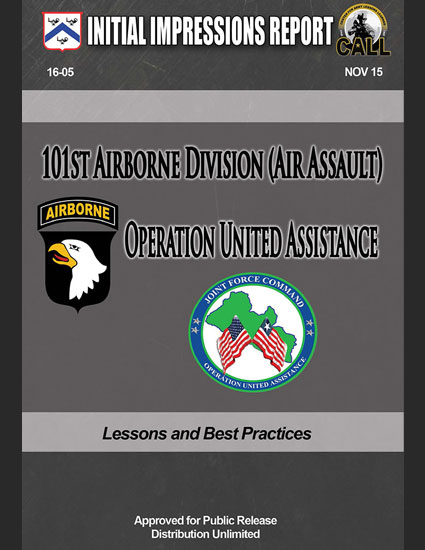 16-05: 101st Airborne Division Operation United Assistance IIR
16-05: 101st Airborne Division Operation United Assistance IIR
This report provides a summary of insights, lessons, and best practices collected from the Commander and staff of the 101st Air Assault Division and the staff of the 101st Sustainment Brigade during the Umbrella Week collection following their return from Operation United Assistance (OUA). The division transitioned to JFC-OUA and led a five-month deployment to Liberia in support of the U.S. Agency for International Development-led mission to fight the spread of the Ebola virus in western Africa.
The United States Corps of Engineers (USACE) Overseas Contingency Operations Playbook provides lessons learned from more than 10 years serving in Iraq and Afghanistan. The playbook's purpose is to capture leaders' significant experiences, observations, issues and perceptions; to share and institutionalize these insights within USACE, the Engineer Regiment, and the Department of the Army to provide a tool for operating effectively in future contingency operations.
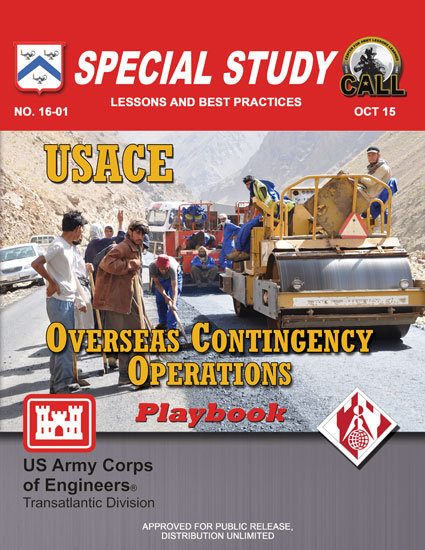 16-01 USACE Overseas Contingency Operations Playbook
16-01 USACE Overseas Contingency Operations Playbook
Humanitarian assistance and disaster relief operations are not new to the Army and the Department of Defense (DOD). We gained experience from Hurricane Katrina in 2005 and the 2010 Haiti earthquake. In the response to the Ebola outbreak in West Africa, President Barack Obama announced Operation United Assistance in September 2014, allowing the military to support the United States Agency for International Development. This was the largest role the military had assumed in combating the spread of a disease or virus. The fight against Ebola was on.
The DOD made critical contributions to the fight against the Ebola virus disease outbreak in West Africa. Chief among these was bringing expertise in mission command, logistics, and engineering to assist in quickly getting health workers and medical supplies into West Africa. This Center for Army Lessons Learned bulletin is the result of many interviews and data collection activities with the U.S. Army Africa (USARAF) staff. It is not meant to be totally comprehensive, but rather to serve as a quick and easy-to-read guide for follow-on units focusing on selected key areas.
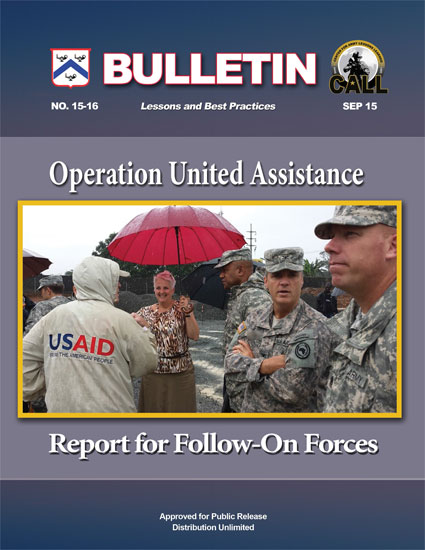 15-16 Operation United Assistance Report for Follow-On Forces
15-16 Operation United Assistance Report for Follow-On Forces

